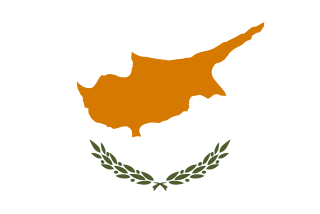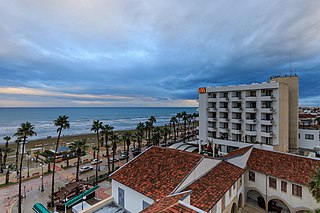Related Research Articles

Cyprus, officially the Republic of Cyprus, is an island country in the eastern Mediterranean Sea. Although it is geographically located in West Asia, its cultural identity and geopolitical make-up are overwhelmingly Southeast European. It is the third largest and third most populous island in the Mediterranean. It is located southeast of Greece, south of Turkey, west of Syria and Lebanon, northwest of Israel and Palestine, and north of Egypt. Its capital and largest city is Nicosia. Cyprus hosts the British-controlled military bases Akrotiri and Dhekelia, whilst the northeast portion of the island is de facto governed by the self-declared Turkish Republic of Northern Cyprus, which is separated from the Republic of Cyprus by the United Nations Buffer Zone.

Nicosia, also known as Lefkosia and Lefkoşa, is the capital and largest city of Cyprus. It is the southeasternmost of all EU member states' capital cities.

Famagusta, also known by several other names, is a city located in the Gazimağusa District of the de facto and unrecognised state of Northern Cyprus. It is located east of the capital, Nicosia, and possesses the deepest harbour of the island. During the Middle Ages, Famagusta was the island's most important port city and a gateway to trade with the ports of the Levant, from where the Silk Road merchants carried their goods to Western Europe.

Halloumi or haloumi is a cheese that originated in Cyprus. It is made from a mixture of goat's and sheep's milk, and sometimes also cow's milk. Its texture is described as squeaky. It has a high melting point and so can easily be fried or grilled, a property that makes it a popular meat substitute. Rennet is used to curdle the milk in halloumi production, although no acid-producing bacteria are used in its preparation.

The Eurovision Song Contest 1988 was the 33rd edition of the Eurovision Song Contest, held on 30 April 1988 in the RDS Simmonscourt Pavilion in Dublin, Ireland and presented by Pat Kenny and Michelle Rocca. Organised by the European Broadcasting Union (EBU) and host broadcaster Radio Telefís Éireann (RTÉ), the contest was held in Ireland following the country's victory at the 1987 contest with the song "Hold Me Now" by Johnny Logan.

Northern Cyprus, officially the Turkish Republic of Northern Cyprus (TRNC), is a de facto state that comprises the northeastern portion of the island of Cyprus. It is recognised only by Turkey, and its territory is considered by all other states to be part of the Republic of Cyprus.

Larnaca, also spelled Larnaka, is a city on the southeast coast of Cyprus and the capital of the district of the same name. With a district population of 144,200 in 2015, it is the third largest city in the country after Nicosia and Limassol.

Paphos, also spelled as Pafos, is a coastal city in southwest Cyprus and the capital of Paphos District. In classical antiquity, two locations were called Paphos: Old Paphos, today known as Kouklia, and New Paphos. It is the fourth-largest city in the country, after Nicosia, Limassol and Larnaca, with an urban population of 63,600 in 2018.

Stass Paraskos was a British-Cypriot painter, sculptor, and writer. Born and raised in Cyprus, he would go on to spend most of his life working and teaching in England, where he famously became embroiled in a 1966 obscenity trial.
Turkish Cypriots or Cypriot Turks are ethnic Turks originating from Cyprus. Turkish Cypriots are mainly Sunni Muslims. Following the Ottoman conquest of the island in 1571, about 30,000 Turkish settlers were given land once they arrived in Cyprus. Additionally, many of the island's local Christians converted to Islam during the early years of Ottoman rule. Nonetheless, the influx of mainly Muslim settlers to Cyprus continued intermittently until the end of the Ottoman period. Today, while Northern Cyprus is home to a significant part of the Turkish Cypriot population, the majority of Turkish Cypriots live abroad, forming the Turkish Cypriot diaspora. This diaspora came into existence after the Ottoman Empire transferred the control of the island to the British Empire, as many Turkish Cypriots emigrated primarily to Turkey and the United Kingdom for political and economic reasons.

Constantinos Christophorou is a Greek-Cypriot singer. He represented Cyprus in Eurovision Song Contest as a solo singer with "Mono Yia Mas" (1996) and "Ela Ela " (2005) and as part of the boy band formation One with "Gimme" (2002).
Greek Cypriots are the ethnic Greek population of Cyprus, forming the island's largest ethnolinguistic community. According to the 2011 census, 659,115 respondents recorded their ethnicity as Greek, forming almost 99% of the 667,398 Cypriot citizens and over 78% of the 840,407 total residents of the area controlled by the Republic of Cyprus. These figures do not include the 29,321 citizens of Greece residing in Cyprus, ethnic Greeks recorded as citizens of other countries, or the population of Northern Cyprus.

Lempa is a village in Cyprus located approximately 4 km (2.5 mi) north of the town of Paphos. It is sometimes written as Lemba, which is also closer to the correct pronunciation. Neighbouring villages are Empa, Kissonerga and Chlorakas.

Turkish Americans or American Turks are Americans of ethnic Turkish origin. The term "Turkish Americans" can therefore refer to ethnic Turkish immigrants to the United States, as well as their American-born descendants, who originate either from the Ottoman Empire or from post-Ottoman modern nation-states. The majority trace their roots to the Republic of Turkey, however, there are also significant ethnic Turkish communities in the US which descend from the island of Cyprus, the Balkans, North Africa, the Levant and other areas of the former Ottoman Empire. Furthermore, in recent years there has been a significant number of ethnic Turkish people coming to the US from the modern Turkish diaspora, especially from the Turkish Meskhetian diaspora in Eastern Europe and "Euro-Turks" from Central and Western Europe.
The year 1963 saw a number of significant happenings in radio broadcasting history.
The British Cypriot community in the United Kingdom consists of British people born on, or with ancestors from, the Eastern Mediterranean island of Cyprus. British Cypriot people may be of Greek, Turkish, Maronite, Lebanese or Armenian descent.
Cyprus was represented at the Eurovision Song Contest 2000 with the song "Nomiza" (Νόμιζα), written by Alexandros Panayi and Silvia M. Klemms, and performed by the duo Voice, consisting of Christina Argyri and Alexandros Panayi. The Cypriot participating broadcaster, the Cyprus Broadcasting Corporation (CyBC), selected its entry through a national final.

Cyprus-Polish relations are foreign relations between Cyprus and Poland. Diplomatic relations between both countries were established during the 1960s. Cyprus has an embassy in Warsaw. Poland has an embassy in Nicosia. The two countries share membership of the European Union and Council of Europe and Organization for Security and Co-operation in Europe. The two countries became members of the EU in 2004.

Despina Olympiou, also known as Dena Olympiou, is a Greek-Cypriot singer, famous in her homeland as well as in Greece. She represented Cyprus in the Eurovision Song Contest 2013 in Malmö, Sweden.

"Replay" is a song by Georgian-born Greek singer Tamta. The song title and artist were revealed on 21 December 2018 by CyBC. The song was written by Alex P. A preview of the song was published on 24 February 2019. The song was performed during the first semi-final of the Eurovision Song Contest 2019 as the Cypriot entry and qualified to the final, where it placed 13th with 109 points.
References
- ↑ "Cyprus, Female Voice and Memory". www.kcl.ac.uk. 23 September 2017. Retrieved 19 April 2020.
- ↑ Stylianou-Lambert, Theopisti; Bounia, Alexandra (2016). The Political Museum: Power, Conflict, and Identity in Cyprus. Routledge. p. 237. ISBN 978-1-315-52103-9.